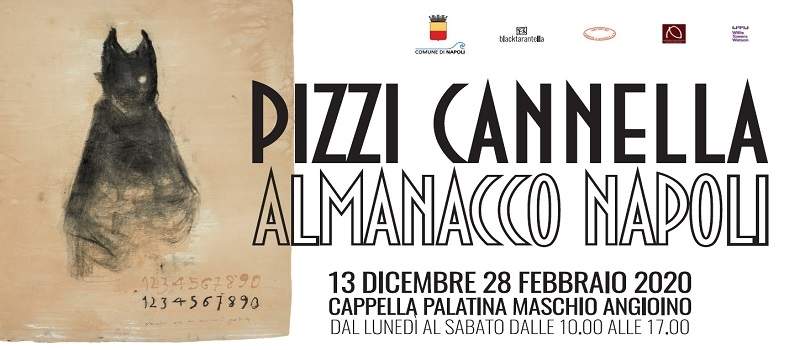The Palatine Chapel at the Maschio Angioino in Naples is hosting Almanacco Napoli, an exhibition of works on paper by Piero Pizzi Cannella (Rocca di Papa, 1955). For the occasion, the exhibition space will be enveloped by the artist’s painting in a circular gaze that rises from the floor to the walls and returns to rest between the pages of notebooks and small watercolor sheets arranged on the tables.
The exhibition, curated by Claudia Gioia, opens Dec. 13 through Feb. 28 and is sponsored by the Naples City Council’s Department of Culture and Tourism, produced by Black Tarantella and thePizzi Cannella Archive.
Pizzi Cannella, a total artist and painter who was among the founders in the early 1980s of the School of San Lorenzo in Rome, chooses the city of Naples, with its history and baroque chiaroscuro, to write a new recapitulatory narrative of his artistic research. More than 150 works for an exhibition only of papers, of different formats, selected along forty years of pictorial research, with the intention of showing the digressions that painting itself has taken.
Says Pizzi Cannella, “You choose the paper, the technique, the water, and then you start as in the opening moves of chess until the variants intervene and there it becomes fascinating because with the work on paper you can create that havoc that due to technical and definitional problems is more difficult to achieve with painting. Standing in front of the painting is like standing in the presence of a stern god. Papers, whether drawing or watercolor, on the other hand, leave you with the ability to do anything and you are freer.”
The body of works in the exhibition starts from small papers such as Lievi spostamenti from 1983, from notebooks such as I vasi dei pesci dell’isola and through a 1983 Girotondo, a 1987Ombra cinese, the 1999 Coralli dell’isola and a 2009 Mappa per andare via arrives at the larger papers such as Cattedrale from 2013.
Almanac Naples is a travel story to be read by letting the painting take you along and accompany you by the titles and words, which sometimes fill the papers, as if by necessity to keep in mind the roads traveled and yet to be traveled, headings of the same intent.
Pizzi Cannella was born in 1955 in Rocca di Papa (RM).
From 1975 he attended Alberto Ziveri ’s painting course at theAcademy of Fine Arts in Rome and at the same time enrolled in the Philosophy course at La Sapienza University. He held his first solo exhibition in 1978, at La Stanza Gallery in Rome. In 1982 he established his studio in theformer Cerere pasta factory, in the San Lorenzo district, giving life together with Bruno Ceccobelli, Gianni Dessì, Giuseppe Gallo, Nunzio and Marco Tirelli, to the San Lorenzo School. Of the same year is his first solo show at Fabio Sargentini’s Galleria L’Attico in Rome (a gallery with which he still collaborates). This was followed in the same season (84-85) by solo shows in New York(Annina Nosei Gallery); that in Berlin(Folker Skulima Galerie); and in the following year at the Triebold Gallery in Basel (a gallery with which he would work until 2002).
He also holds, over the years, several solo exhibitions in private Galleries in Italy and abroad: Cannaviello Gallery in Milan (1987, 1990, 1991, 1996); Vidal-Saint Phalle Gallery in Paris (1990, 1993, 1997, 1999, 2004, 2008, 2014); Bagnai Gallery in Siena and Florence (1991, 1994, 1997, 1999, 2002, 2006, 2010, 2013); Di Meo Gallery in Paris (1993, 1997, 2006); Otto Gallery in Bologna (1998, 2000, 2004, 2008, 2013); Volume Gallery in Rome (2000); Lo Scudo Gallery in Verona (2003), Bibo’s Place Gallery in Todi (2016) and Rome; Pastificio Cere Foundation in Rome (2016); Mucciaccia Gallery in Rome (2012, 2019); Singapore at Partners & Mucciaccia Gallery (2014) and in 2018 in the Gallery’s London office.
His works are on permanent display in major public and private collections, including: Palazzo Reale in Milan, Galleria d’Arte Moderna e Contemporanea in Turin, Galleria d’Arte Moderna in Bologna, Mumok Museum in Vienna, Hotel des Arts in Toulon, Museum of Contemporary Art in Beijing, MACRO in Rome, San Giorgio in Poggiale in Bologna, Biedermann Motech in Villingen-Schwenningen (Germany), at the Museum of Modern Art in Saint Etienne (France), and at the Hermitage in St. Petersburg (Russia).
To learn more about the artist you can visit the official website of the Pizzi Cannella Archives.
Source: release
 |
| Naples, works on paper by Piero Pizzi Cannella are on display at the Maschio Angioino |
Warning: the translation into English of the original Italian article was created using automatic tools. We undertake to review all articles, but we do not guarantee the total absence of inaccuracies in the translation due to the program. You can find the original by clicking on the ITA button. If you find any mistake,please contact us.